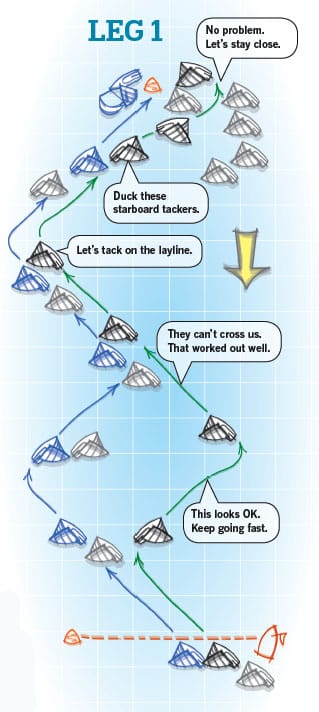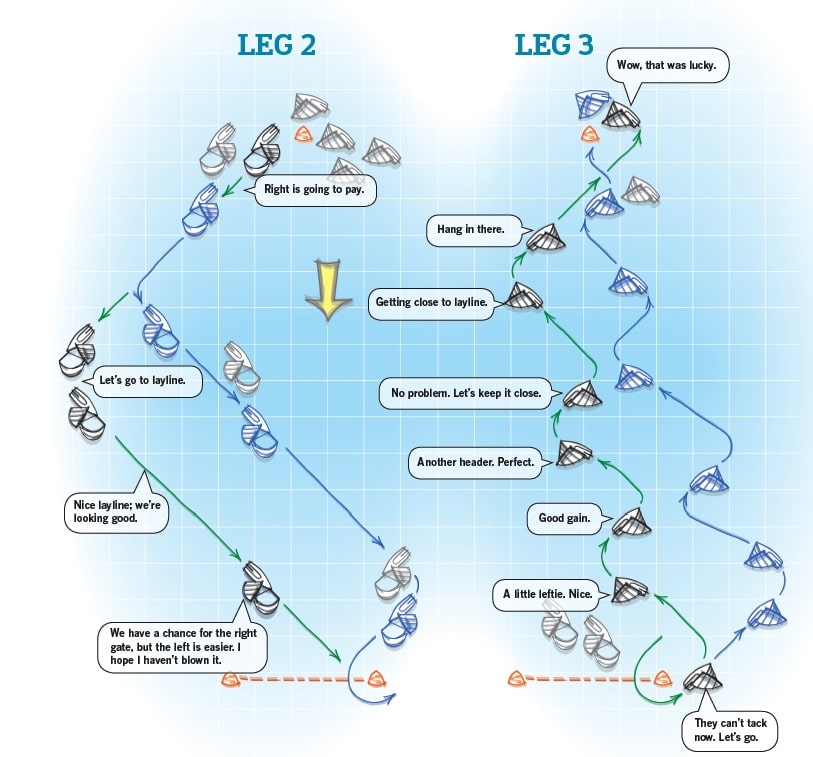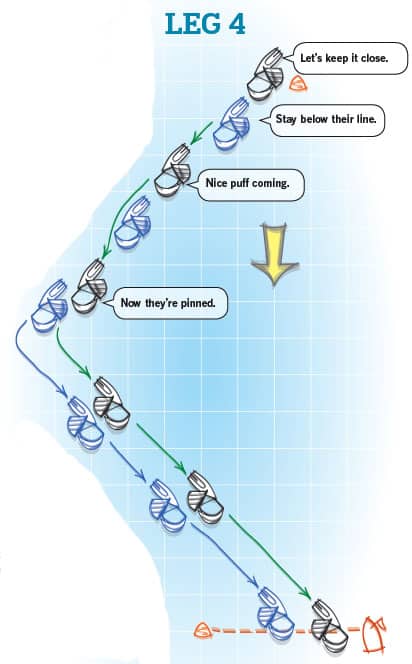I’d like to share one recent experience from the 2011 Melges 20 Gold Cup in Miami, where I held the middle position, crewing for Alesandro Rombelli, a relative newcomer to sailing, but a quick learner. Our forward crew was the calm and cool Giorgio Tortarolo. We were having a good regatta, much to our surprise (in the previous regatta we had placed 23rd), and after three days of racing, we were in second place, 4 points ahead of third and 8 points behind the series leader, the formidable Luca Lalli, of Italy, and his team on B-Lin. There were two races scheduled, and the forecast was for 12 to 20 knots from the northeast. As we sailed out to the start, we talked about trying to have a solid race in the first one and seeing how the points played out, not worrying about the other boats.
We had a good first race, passing two boats right before the finish to get fourth. The boat just behind us in the series was a few places behind, so we were in pretty good shape on them. Even better, B-Lin, the regatta leader, finished 12th, so we were now tied going into the last race. This vastly exceeded our expectations, and we tried to keep our cool: the final race would be a “who-beats-who” for all the marbles.

Leg 1: Sail Clean
Not being super confident in our speed or our boathandling compared to B-Lin, we decided not to engage them, but rather try to get a good start and see what happened. Before the start, we discussed the importance of focusing on execution and not getting too flustered, no matter what happened. We had already done better than we expected, so in a way the pressure was off. But on the other hand, being tied for the lead with one race to go, the anticipation of winning a Gold Cup was too much to ignore.
In 13 to 20 knots, with 15-degree oscillating shifts, I knew it was important to stay on the lifted tack, hopefully in clear air. We were looking at “stay-in-phase” conditions.
We lined up for the start in our usual manner, focusing on being the right distance off the line during our final approach. But B-Lin snuck in and set up to leeward. “Dang,” I thought. Another fast boat set up to windward, and as we sheeted in for the start, we were a little slow to accelerate. Within 30 seconds, we were under pressure from both boats, and we got flushed out soon after.
“Less than ideal,” I thought.
At this point, our chances of winning the regatta were not looking good. Luckily, we were getting headed and had a gap to windward to tack into. Immediately after the tack, things looked brighter. We had a good lane with clear air, we were on the lifted tack, and B-Lin was pinned by the other boat.
“We’re back in the hunt,” I said.
We sailed for about 90 seconds, got a good header, and tacked back. The leaders from both sides were ahead of us, but as we approached B-Lin, they were unable to cross and tacked to leeward.
“That worked out well (if a bit lucky).”
We sailed on starboard all the way to the port layline and tacked in a good leebow position on B-Lin. The leaders from the right were well ahead, but at this point we were simply executing our game plan: stay in front of_ B-Lin_.
As we approached the weather mark, we had to duck a string of starboard-tack boats on the starboard layline, being extra careful not to foul anyone. Somehow B-Lin slipped through and tacked right in front of us.
“Lucky for them,” I thought, “but there’s lots of racecourse left.”
Leg 2: Stay Close
We had a good spinnaker set and got going well right away. Extending to the right, B-Lin jibed 15 lengths shy of the layline. We kept going until we reached the layline and jibed in clear air and good pressure.
“We have a good opportunity here.”
As we approached the leeward gate on port jibe, B-Lin jibed clear and came in on the starboard-jibe layline. We were bow to bow, but there was another boat between us, so we were third in line for the left-hand mark (looking downwind). We could have jibed for the right mark instead and had a clear rounding with a split, but I decided against it because it would’ve been a more challenging manuver.
“Big mistake,” I thought, “I hope we didn’t just blow our chance.”

Leg 3: Make a Move
We rounded the left gate two places behind. Things were not looking good. A boat ahead normally gets into clear air and water sooner and extends its lead. Still, the race was only half over.
“Keep cool,” I thought.
We sailed on port for about a minute, cleared the boats coming downind, then tacked to starboard in a place where B-Lin had to continue past another starboard tacker’s bad air. This gave us a little leverage.
“Nice move.”
After a minute, we got headed and tacked. We had gained; B-Lin‘s lead was now down to just two lengths. They tacked in a tight leebow position, forcing us to tack away. We sailed on starboard until we met the next header, and tacked back. _B-Lin _leebowed us again, and we had to make another clearing tack. We were nearly on the port layline, so we had to tack back. Again they tacked on our lee bow, still two lengths ahead. But as they approached the mark, they were blocked by a starboard tacker and had to make two extra tacks. We rounded the last weather mark right on their tail, with the regatta on the line.
“That was lucky, but we’ll take it!”

Leg 4: Go for the Pass
We both had good sets. The breeze was pretty puffy, but still 15 to 18 knots. We hung on their stern for a while, trying really hard not get above their line and into their weather stern wake. But they slowly extended, as often happens, and as we got down the leg our options started to run out: we could’ve jibed away, hoping for a favorable split, but I had a feeling the right corner was going to pay, as it had most of the regatta.
As we closed in on the final layline, we snagged a puff and slid below B-Lin‘s line, which put us into a position where they couldn’t jibe. In one instant we went from losing to winning.
“This is looking better.”
We used the boats ahead to call a good layline to the finish, which was now half a mile away. Just one more jibe to execute.
I could tell Alesandro was nervous, but he kept his wits through the jibe, and we were right back onto a plane. B-Lin had to wait until we jibed, and when they did, we had them in our bad air. We sailed through the finish line and exchanged high-fives all around. “Wow, that was pretty lucky,” I thought.
“But on the other hand, we never gave up, and we used the good fortune that came our way!”
Pro Tips
Know the scores going into the last race, and have a good handle on the combinations that you need.
Stay calm, even when things don’t seem to be going well.
Keep trying to do the smart, rational thing. Don’t take a wild, low-percentage move unless you’re totally out of options.
Try to stay in phase, even when you’re match racing another boat.
Recognize that sometimes you get lucky, but often more luck comes to those who do the above things well.









